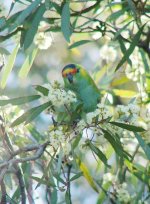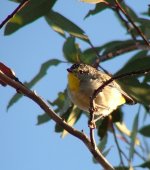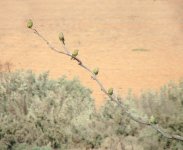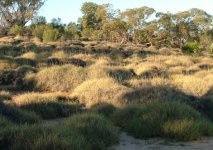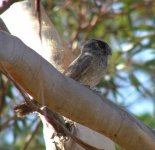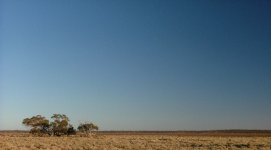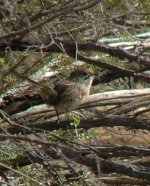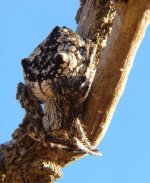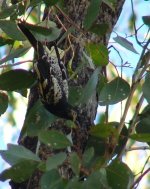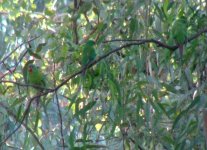MikeMules
Well-known member
Or, What I Did On My Vacation (in 3 parts + list)
Hi all, last week, my father and I went on a trip to northern Victoria, to see what we could see. Well, we came back 1500km later with 133 species, and 7 lifers (for me, 6 for him).
Leaving at 6:30am from Melbourne, we set out for Pink Lakes, about 600km to the NW. Early birds were the standard species; Rainbow Lorikeet, Little Raven, Red-rumped Parrot, Magpie-Lark and the usual ferals (Feral Pigeon, Starling, Common Myna). Our first stop of interest was about 2 1/2 hours later, north of Inglewood, where the Whipstick Mallee was in flower. We saw the first of many Yellow-tufted, Fuscous and White-eared Honeyeaters, dozens of Musk and Purple-crowned Lorikeets (pic #1), and two Diamond Firetails. Also, our first of hundreds of Spotted Pardalote (pic #2) were seen – one of a handful of species we saw every day of the trip.
We stopped for lunch about 200km further north at Lake Tyrell – a large salt lake with sparse saltbush, and little else in the way of vegetation. And there, lifer #1: Elegant Parrot (pic #3) – about a dozen perched in the noonday sun on the skeletons of long-dead trees. These were closely followed by mixed flocks of White-fronted Chats and Orange Chats, one of the prettiest birds in the country. A very pleasant lunch was only interrupted by some dust-throwing dirt-bikers, and then we headed back to the main highway, only stopping for dad’s first lifer of the trip: Black Falcon, which rose up from the saltpan, and glided away in front of, then alongside us. Luckily we had Debus’ Field Guide to Birds of Prey handy for a quick double-check, before we were on our way.
3:30pm saw us raising Pink Lakes (pic #4), in the south of the Murray-Sunset National Park. It was just us, and the two other campers on the opposite side of one of the lakes. Mallee Ringnecks, Blue Bonnets and Mulga Parrots were common, and remained common for our 4 days in the mallee. The final highlight for the day were pink Major Mitchell Cockatoos flying over the pink lakes at sunset.
Hi all, last week, my father and I went on a trip to northern Victoria, to see what we could see. Well, we came back 1500km later with 133 species, and 7 lifers (for me, 6 for him).
Leaving at 6:30am from Melbourne, we set out for Pink Lakes, about 600km to the NW. Early birds were the standard species; Rainbow Lorikeet, Little Raven, Red-rumped Parrot, Magpie-Lark and the usual ferals (Feral Pigeon, Starling, Common Myna). Our first stop of interest was about 2 1/2 hours later, north of Inglewood, where the Whipstick Mallee was in flower. We saw the first of many Yellow-tufted, Fuscous and White-eared Honeyeaters, dozens of Musk and Purple-crowned Lorikeets (pic #1), and two Diamond Firetails. Also, our first of hundreds of Spotted Pardalote (pic #2) were seen – one of a handful of species we saw every day of the trip.
We stopped for lunch about 200km further north at Lake Tyrell – a large salt lake with sparse saltbush, and little else in the way of vegetation. And there, lifer #1: Elegant Parrot (pic #3) – about a dozen perched in the noonday sun on the skeletons of long-dead trees. These were closely followed by mixed flocks of White-fronted Chats and Orange Chats, one of the prettiest birds in the country. A very pleasant lunch was only interrupted by some dust-throwing dirt-bikers, and then we headed back to the main highway, only stopping for dad’s first lifer of the trip: Black Falcon, which rose up from the saltpan, and glided away in front of, then alongside us. Luckily we had Debus’ Field Guide to Birds of Prey handy for a quick double-check, before we were on our way.
3:30pm saw us raising Pink Lakes (pic #4), in the south of the Murray-Sunset National Park. It was just us, and the two other campers on the opposite side of one of the lakes. Mallee Ringnecks, Blue Bonnets and Mulga Parrots were common, and remained common for our 4 days in the mallee. The final highlight for the day were pink Major Mitchell Cockatoos flying over the pink lakes at sunset.




